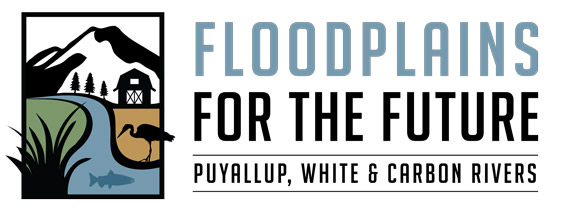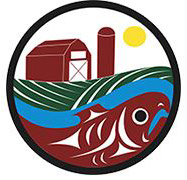Floodplains and estuaries are dynamic and diverse landscapes that extend from the headwaters of rivers, often high in the mountains, to the mudflats and salt marshes where the rivers enter the Puget Sound. These critical habitats are the links between land and sea—creating and supporting a more diverse landscape than would be otherwise possible. And from time immemorial to today these habitats have supported the lives and cultural practices of Native Americans.
Special Announcement: The Habitat Strategic Initiative Lead is updating the Floodplains and Estuaries Implementation Strategy. Read more below to see how you can get involved.
Why are Floodplains and Estuaries Important?

Photo Credit: Joseph Lamb
A healthy floodplain is a place where both people and nature thrive. Each reach of a river contains important salmon habitat and prime farmland, and each experiences damage from flooding.
From upland forests to farmlands, prairies, and urban centers-rivers and river delta estuaries traverse a diverse human and natural landscape. Communities across Puget Sound are beginning to envision and implement a new way of managing floodplains.
Integrated floodplain management is a new form of planning, action, and management where partners agree on a set of shared visions, strategies, and actions to improve floodplain health. Instead of competing against one another for limited resources, partners work together to pursue diverse funding opportunities and develop a suite of integrated projects that collectively moves stakeholders across the watershed closer to achieving their goals.
River-basin planning is a collaborative approach where residents and stakeholders impacted by an issue are integrated into the process of creating solutions for their community. By integrating residents and stakeholders into the process, a river-basin plan results in a strategy that proposes coordinated actions and projects that benefits local agricultural operations, fish habitat, and flood risk reduction.
Floodplains and Estuaries Implementation Strategy Update
The Habitat Strategic Initiative Lead will be updating the Floodplains and Estuaries Implementation Strategy in 2025-2026. The goal of this update is to integrate new information so the strategies can better guide coordinated recovery planning and implementation in Puget Sound. Updates to the Implementation Strategy will focus on:
- Adding new information and progress that has occurred in the last ten years.
- Integrating climate change and human wellbeing.
- Assessing current uncertainties, research needs, and cost information.
Updates will be informed by input gathered from the 2025 Action Agenda workshops and other engagements.
Timeline
- June – September 2025: Initial outreach to tribes and partners; finalize scope of update.
- October – December 2025: Tribal and partner engagement and input; host workshop focused on both Land Development and Cover and Floodplains and Estuaries Implementation Strategies.
- January 2025 – April 2026: Update Implementation Strategy documents.
- May – June 2026: Public comment period.
- June 2026: Final strategy published.
How to be Involved
- To provide input on updates needed to the Floodplains and Estuaries Implementation Strategy, complete this form by Jan. 9th, 2026.
- HSIL hosted a workshop on Oct. 27th about land use and floodplains to support updates to both the Land Development and Cover and Floodplains and Estuaries Implementation Strategies. See the workshop agenda and slides for more information.
To stay up to date on the Implementation Strategy updates, sign up for our SIL email list.
With questions, contact Rachel Latchford, Floodplains and Estuaries Implementation Strategy Lead, at rachel.latchford@dfw.wa.gov.
How Do We Get to Where We're Going?
Historically, floodplain management only focused on preparing for and reacting to flood disasters. Integrated Floodplain Management brings in additional community stakeholder voices into the management of flood-prone river systems. Programs like Floodplains by Design and Floodplains for the Future are two examples of an Integrated Floodplain Management approach.
Developing and implementing projects which address local needs is critical to successfully recover river and estuary habitat within Puget Sound. This can be achieved by supporting an integrated management approach to prioritize, design, and implement reach-scale restoration and protection projects within Puget Sound river basins and watersheds. One example is the Snohomish County Reach-Scale planning project – click here to read more about their success!
Incorporating risk tolerance and cost subsidy analyses will reduce development within floodplains and estuary habitats, prioritize the best areas for the purchase of development rights, and determine the long-term costs of development within floodplains and estuaries. This approach highlights the opportunities to incorporate the economic risks and costs of development into land-use planning in floodplain and estuary habitats. These analyses will lay the groundwork for planning forums to identify implementation-ready actions.
What Can You Do?
Examples of Integrated Management Programs in Washington State
Is your organization interested in an integrated management approach? The Nature Conservancy has created a clearinghouse of information that provides guidance, tools, best practices and other resources to help you and your organization enter into and maintain healthy, effective and productive partnerships.



